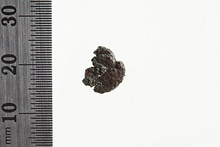| Collection: | Corinth | |
| Type: | Basket | |
| Name: | Nezi Field, context 1024 | |
| Area: | Nezi Field | |
| Title: | Baulk west of 791 at NE edge of excavation area | |
| Category: | Deposit | |
| Notebook: | 1107 | |
| Context: | 1024 | |
| Page: | 0 | |
| Date: | 2013/04/10 | |
| Stratum: | 15% inclusions; tile, ceramic sherds, fine and medium pebbles | |
| Description: | Top slope of the context is level down to the S. The soil color is dark yellowish brown. The soil compaction is firm. The soil is poorly sorted. It is clayey silt. | |
| Notes: | With this context, we moved to the area north of pit 870, as it is now one of the latest parts of our area. Immediately to the east of and overlaying this small context was a depression filled with 19th century debris, excavated in the 2012 season as 919. The soil here is quite clayey and differs from all the other soils so far excavated in our excavation area this season. There are also some large roots disturbing it. A drain was exposed at the bottom of this context and the soil of the current context filled it. The drain consisted of a layer of flat tiles laid horizontally along its bottom, and the sides consisted of cobbles mortared together. The top of the sides of the channel appear to have been covered by flat tiles, now broken and not evident in some places. This tile may have fallen onto the the fill within the drain as a result of its collapse. It appears that these top tiles are slightly different than those at the bottom of the drain. The dimension of the bottom tiles is 0.295 by 0.280 m, as measured by Guy Sanders. He also noted that the dimension of the tiles is similar to the ones from the bath at Panagia, dated to the 6th c. CE and built on the Late Antique Roman foot as a standard measure. One of the tiles has the impression of a dog's paw. The drain runs N-S and is cut on the south side by the robbing trench (919) associated with the wall 918, which runs E-W. The flat tiles of the bottom of the drain continue approximately 0.70 m to the north, outside of the Blue area for 2013. The drain may be related to the well further north, just east of the Turkish house. Sanders theorizes that the drain may be related to both the well and the Late Antique wall (918) running east west, and that there may have been a doorway over the drain, but not enough remains of either the wall or the drain to say for sure. | |
| Context Pottery: | Fineware. AfRS form 99a1 rim. ; Fineware. early roman3 bodysherds. ; Fineware. preroman4 bodysherds. | |
| Pottery Summary: | 9 frag(s) 0.01 kg. (0% saved) fineware. | |
| 90 frag(s) 0.7 kg. (0% saved) coarseware. | ||
| 22 frag(s) 0.1 kg. (0% saved) cooking ware. | ||
| Context Artifacts: | iron, nail, square shank, 1; shell, with yellow pigment, 1 | |
| Period: | Late Roman (5th -6th c AD) | |
| Chronology: | mid 6th c. CE | |
| Grid: | 260.04-259.46E, 1014.81-1016.11N | |
| XMin: | 259.46 | |
| XMax: | 260.04 | |
| YMin: | 1014.81 | |
| YMax: | 1016.11 | |
| Site: | Corinth | |
| City: | Ancient Corinth | |
| Country: | Greece | |
| Masl: | 85.72-85.98m. | |
| References: | Coin: 2013 47 |
|
References Classifications Sign in Provide feedback |
|
